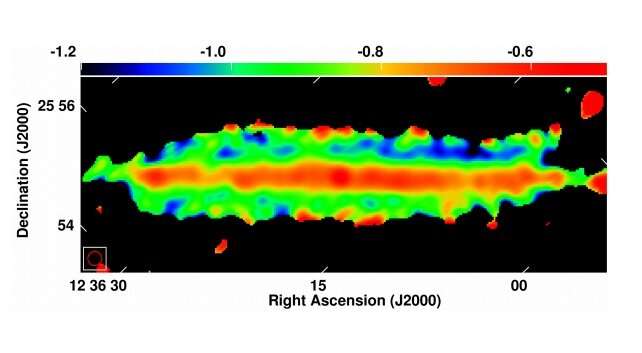NGC 4565: non-thermal radio spectral index between 144 (LOFAR) and 1570 MHz (JVLA) at 20 arcsec FWHM resolution. The major axis has been rotated so that it is horizontal. The size of the synthesised beam is shown in the bottom left corner. Image credit: Heesen et al., 2019.
Using the LOw-Frequency ARray (LOFAR), astronomers have discovered a diffuse radio halo around the spiral galaxy NGC 4565. The finding, reported in a paper published July 16 on the arXiv pre-print server, could shed more light on the nature of NGC 4565, disclosing important insights about star-forming activity and the distribution of cosmic-ray electrons in this galaxy.
Radio haloes are commonly observed around late-type spiral galaxies seen in an edge-on orientation. Studies show that the emission in radio halos is dominated by the non-thermal radio continuum component, indicative of cosmic ray electrons (CRe) and magnetic fields.
Very little is known about the transport of cosmic rays in galaxies other than Milky Way. Low-frequency radio continuum observations have the potential to change this. They allow to investigate the oldest CRe far away from star formation sites in the halos of galaxies.
So a team of astronomers led by Volker Heesen of University of Hamburg in Germany used LOFAR to conduct deep, low-frequency (144 MHz) observations of NGC 4565. Located about 38.8 million light years away, the target is a late-type spiral galaxy at an almost edge-on orientation. It is a quiescent galaxy with a low star-formation rate and an average mass surface density.
"We have observed the nearby edge-on spiral galaxy NGC 4565 with LOFAR at 144 MHz in the radio continuum to measure the distribution of CRe and magnetic fields," the astronomers wrote in the paper.
During the observations, the astronomers detected a warp in the radio continuum of NGC 4565 that is reminiscent of a neutral hydrogen line (HI) warp and identifying a slight flaring of the galaxy's radio halo. The researchers assume that this flaring is caused by the warp as the vertical intensity profiles are asymmetric, which is in agreement with the warp. According to the study, a minimum age for the warp was estimated at approximately 130 million years. This is the spectral age of the galaxy's CRe, during which they are transported into the warp.
Taking into account the results, the astronomers concluded that the NGC 4565 may be in the aftermath of a period with more intense star formation. They added that the galaxy has a relatively old population of CRe that has slowly diffused away from the star-forming disc.
"The weak outflow that may be seen at higher frequencies was therefore probably stronger in the past, which explains the diffusive low-frequency radio halo," the scientists wrote.
Emphasizing that NGC 4565 could be in transition from an outflow- to an inflow-dominated phase, the researchers noted that this could explain why it behaves differently to NGC 7462, the only other galaxy in which they have detected a diffuse radio halo. They added that their research proves the significance of LOFAR observations for improving the understanding of cosmic rays and galaxy evolution.
More information: Warped diffusive radio halo around the quiescent spiral edge-on galaxy NGC 4565, arXiv:1907.07076 arxiv.org/abs/1907.07076
© 2019 Science X Network
























